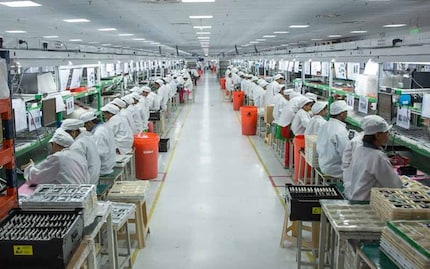
Background information
Security alert: Meitu - the app catapults your personal data to China
by Dominik Bärlocher

Miklagard wrote to tell us he’s been wanting a new phone with a small screen for ages now. It looks like he shouldn’t be counting his chickens just yet. Here’s why.
Miklagard left these requests in the comments section during the LG G7 live stream. At that time we still didn’t know much about the phone in question.
And Miklagard isn’t alone there. Because I read all the comments under my articles, I already know him. Miklagard is the champion of small phones and he really hopes we’ll see a revival of them. While I’m at the Zoo train station in Berlin, I try and find some answers for him.
Small smartphones are a thing of the past. Apart from a few mavericks and eccentrics, no one is making smartphones with a screen size any smaller than five inches or 12.7 centimetres. Miklagard, you probably don’t want to hear this, but you’re in the minority. If this minority was just a bit bigger, it might spice up the landscape of the smartphone market a bit.
Here’s the thing. If the market for small phones was sizeable enough, manufacturers would have a different kind of problem on their hands. The biggest challenge would probably be battery performance. I mean, the industry already has us well trained. We accept we have to charge up our smartphone every evening. It’s the usual plug-it-in-and-go-to-bed routine. Come on, I bet you do the same.
But when you look at a smartphone without its back panel, you’ll see that for the most part, performance is down to the size of the phone. That’s because the battery takes up the bulk of the space behind the screen. With that in mind, there are two options if we go down the road of smaller smartphones:
Neither sound great from an end user perspective. But I’m sure there are nerds and engineers out there who’d be happy to accept the challenge. Yet, the market would certainly put a spoke in their wheel.
The outlook is even bleaker for mini smartphones. If it’s only me, Miklagard and a few of my colleagues expressing interest in mini phones, there’s no chance any manufacturer, big or small, will invest in the development of a flagship. The undeniable reality is smartphones cost a lot to develop. A hell of a lot.
But anyway, back to small phones. User /u/S4G3R_BUG went on record in 2017 with the following statement on the social content aggregation platform Reddit.
5.5” is pretty common, with 6
The US, the other place where users have been calling for small screens every now and then, makes up 4.3% of the world’s population with its 325 million people. If we combine that with the 0.1% that Switzerland represents, then you have 4.4% of the world making a song and dance about small phones.
Of course, we are just blindly assuming the whole country wants small phones. However, the not altogether representative proportion of our community shows that Miklagard is the only one who’s shouting from the rooftops about wanting a small phone.
Now that we’ve established there’s not a sizeable section of the market interested in small smartphones, it’s time to take a look at the smartphone development and production process in general. When a big manufacturer of the likes of Samsung makes a phone, the first few hours of development are based on several key thoughts. There’s certainly one that takes centre stage:
How many can we sell?
This question is what stops the average market from producing flagships with small screens. Having a niche is fun and all, but if it’s not profitable then no company will want to have one.
But if in the end Samsung does decide to put mini phones into production, they’d have to contend with the thorny issue of pricing. The phones would no doubt be disproportionately expensive, as they’d have to bear the development costs and profit margin. It’s not like Samsung would be happy to absorb losses.
And then there’s the seller margins you have to cover. I mean, they’re hardly doing their job purely out of the goodness of their own heart. In terms of the production process, Samsung wouldn’t be able to fall back on current best practices, as these are designed for large screens. In other words, they’d pretty much have to start from scratch. And that makes development disproportionately expensive.
This is also reflected in the components. Given the fact current industry standards are for large phones, it would cost a lot to buy new components that would fit or to have parts custom-made. Result? The parts would also be disproportionately expensive.
And you guessed it: All of these costs have to be shouldered by the very niche that doesn’t have a lot of customers. That’s why it’s absurd to think we could have a mini phone at a flagship price. If half the people in that niche can’t afford the price tag, then Miklagard will soon be all alone with his dreams of a small phone.
So, I’m sorry, Miklagard. It looks like nothing will come of it.
But that’s not to say that Miklagard and Co. have to wander around with a massive brick or no phone at all. There is at least one solution apart from the obvious one.
First, the obvious option: do up an old phone. iPhones are good for this, as Apple continues to offer software updates for older phones. Android developers, on the other hand, often stop delivering updates for elderly models. That means an iPhone 6s can be updated so it uses the current iOS operating system. Spec-wise, the 6s has a 4.7-inch screen. If that’s not small enough, try the iPhone 5c, where iOS 10.3.3 still runs smoothly. After that, things get a bit hairy.
That’s that done and dusted. Thanks for giving me the inspiration for this article, Miklagard, even though as a phone buff I’ll never be able to see what the fuss was all about.
Journalist. Author. Hacker. A storyteller searching for boundaries, secrets and taboos – putting the world to paper. Not because I can but because I can’t not.
Interesting facts about products, behind-the-scenes looks at manufacturers and deep-dives on interesting people.
Show allOut-takes. They’re our favourite thing. Sometimes when video producer Stephanie Tresch and I are away for work we can’t help but jabber away – at times it’s even when we’re on camera. But it’s quite rare for us to be able to pick out sections from that material that make a shred of sense. As a general rule, we just keep the out-takes for ourselves. But today we’re doing something different. And we’ve got reader Miklagard to thank, as he is the one who prompted me to do a short video editorial on small phones.
Here’s hoping it’s a mobile you can actually use and not one of those big bricks that breaks as soon as you even look at it because of its design. And please, no screens bigger than five inches. In fact, even smaller would be better. Oh, and no overlapping screen edges. A few other things on my requirements list: Android One, headphone jack, Qi charging.

Even if the whole of Switzerland woke up one morning convinced that every mobile phone user needed a four-inch phone, there’d only be a measly 8.4 million of us. It’s just not worth developing a brand new phone to only shift eight million pieces. Sadly, Switzerland isn’t the specific target market or in some way a benchmark for launching the pinnacle of all smartphones.
The big money for smartphones isn’t in Europe. At the moment, China and India seem to be calling the shots. The US is slightly less significant but still a big market. These industry statistics result in hilarious things, like the beauty filter you have to deactivate on almost every phone. Phone users in China love enhancing their looks with AI. This can mean anything from narrowing their face, to making themselves pale and giving themselves big eyes. In Europe, on the other hand, it just looks disconcerting.
Then /u/matterwitu piped up in the comments. He explained he was originally from America but living in India and working as a product manager for the Chinese smartphone manufacturer Xiaomi. It was impossible to confirm if this was true or not, but he did follow up with more details.

One reason why people prefer big phones is because many people don't have their own computers. When a smartphone has to do everything, it's better to be 5.5
Let’s talk figures. Remember I said the maximum phone-using population of Switzerland was 8 million? The population of India is 1.3 billion, that’s 1,300 million phone users, while China’s population is 1.4 billion; 1,400 million. All in all, that comes to 2.7 billion people, which is 36.9% of humanity, based on a world population of 7.3 billion.

When it comes to alternatives, you’ve got dumb phones. Nokia continues to invest most of its energy in KaiOS and leave WhatsApp, one of the most important communication channels in Switzerland, out in the cold. There’s also the Swiss manufacturer Smilyphone that’s dabbling in the world of smartphones. This Smilyphone runs on an Android version with the help of WhatsApp.